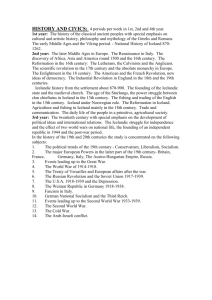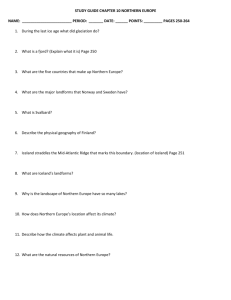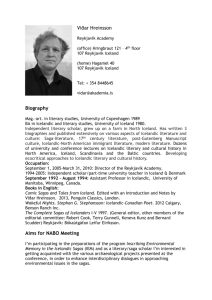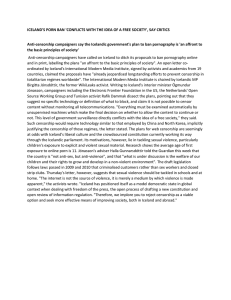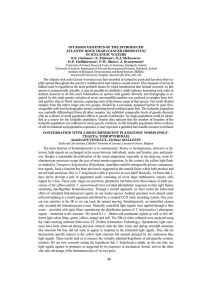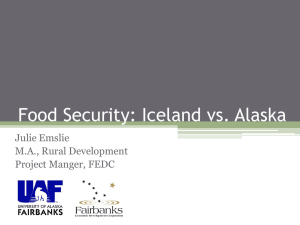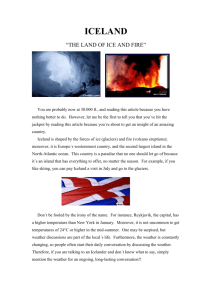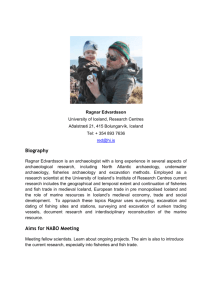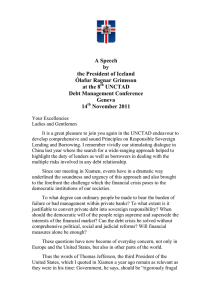Corporate Tax Revenue % of GDP
advertisement
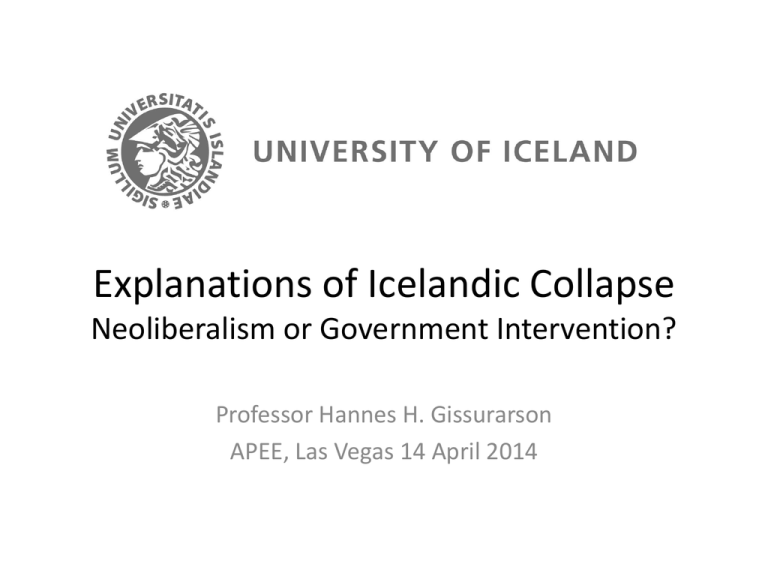
Explanations of Icelandic Collapse Neoliberalism or Government Intervention? Professor Hannes H. Gissurarson APEE, Las Vegas 14 April 2014 What Happened in Iceland in 2008? • Icelandic bank collapse no worse a crisis than in many other European countries • Icelandic banking sector big, but so were such sectors in Switzerland and the UK • Icelandic bankers reckless, but not more so than in other countries • Worked under same regulatory framework as in other EEA countries • Real explanations: Vulnerable situation, crucial decisions Seven EU countries hit harder GDP Contraction 2009 in % Hungary Iceland Ireland Rumenia Slovenia Finland Estonia Lithuania Latvia 0 5 10 15 20 No more “oversized” than others United Kingdom Iceland Ratio of short-term liabilities to GDP Switzerland Belgium 0 50 100 150 200 250 300 No more “reckless” than others • UBS bailed out: fined $1.25 bn for destroying documents on Jews; $780 mn ffor assisting in tax evasion; $1.5 bn, for rate rigging • Danske Bank bailed out (with dollars from Fed) • RBS bailed out, £45 billion in capital, £275 in liquidity: fines for rate rigging, money laundering for Iran and Sudan • ING bailed out, €10 billion in capital: fines for money laundering Others Needed Help: Currency swaps • • • • • • • • Aggregate transactions with CBs: $10,057 bn ECB $8,011 (79.7% of total) CB of the UK $919 bn CB of Switzerland $466 bn CB of Denmark $73 bn CB of Sweden $67 bn CB of Norway $30 bn Also CBs of Japan, Korea and Mexico No less regulated than others • Iceland joined EEA in 1994 and operated under same financial regulation as other member-states (including 27 EU countries) • Reserve requirements same as in other EEA member-states; reduced, only to make them equal to those of competing European banks • Free market reforms in 1991–2004, but only to bring Iceland into line with neighbours 1991–2004 Reforms • Corporate subsidies cut • Tax reductions: corporate tax from 45% to 18%, other taxes simplified and reduced • Privatisation, revenue used to pay up public debt • Stabilisation, inflation brought down, ITQ system in fisheries further developed • Pension reforms, pension funds made sustainable • Legal reforms: public administration, information • Consequence: Good reputation, high ratings More Revenue with Lower Rate 55 1.3 50 1.2 45 1.1 40 Corporate Tax 35 Rate 30 1.0 0.9 Corporate Tax Revenue % of GDP 25 0.8 20 15 0.7 1990 Corporate Tax Rate 1995 2000 2003 Corporate Tax Revenue % of GDP Irony: High Ratings Led to Bubble Aaa Aa1 Aa3 A1 A1 A2 Baa1 Baa3 1989 1991 1993 1995 1997 1999 2001 2003 2005 2007 2009 External Debt: 2004 Crucial Year 16000000 14000000 12000000 10000000 8000000 External debt in millions of kronur 6000000 4000000 2000000 0 1992 1996 2000 2004 2008 From Market to Crony Capitalism • 1991–2004 market capitalism: competition, independent judiciary, free media, economic power separate from political power • 2004 battle about media law, Oddsson loses, Jon Asgeir Johannesson of Baugur wins • 2004–2008 crony capitalism: Johannesson owned media, supported by politicans (and supporting them), cooperative judiciary Baugur Bubble 6000 5000 Loans to Baugur and related companies 4000 Loans to Exista and related companies 3000 2000 Loans to Landsbanki main owners and related companies 1000 0 1/1/05 1/1/06 1/1/07 1/1/08 Hence, additional systemic risks • General international risks: moral hazard; government mistakes; difficulty of pricing risk with new techniques • One additional risk for Iceland, SIC: too much cross-ownership, overvalued assets, Jon Asgeir Johannesson and his cronies • Another additional risk for Iceland: field of operations all of EEA; field of institutional support Iceland alone Three crucial decisions abroad • 24 September 2008, Fed refuses to make currency swap agreements with Iceland, makes them with Scandinavia at same time • 7 October 2008, British Labour government closes the two Icelandic-owned banks in England, bails out all other banks at same time • 8 October 2008, British Labour government uses anti-terrorism law against Icelandic companies, stopping all transfers to or from Iceland, making recovery impossible Unnecessary losses • Asset management section of Singer & Friedlander sold for £5 mn, real value £30 mn • Glitnir Norway sold for NOK 300 mn, had been bought year before for 3.1 bn • Finn Haugan, chairman of Norwegian Guarantee Fund, also leader of savings banks buying Glitnir Norway! Valued month later NOK 2 billion • Glitnir Sweden sold for SEK 60 mn, had been bought 4 years earlier for SEK 380 mn • Glitnir Finland sold for €3,000, shareholder value abouve €40 mn, sold 2013 for €200 mn Lessons from Bank Collapse • • • • Bail-out not possible: Blessing in disguise Banks did not bring down Iceland: governments Extensive regulation did not hinder crisis Strictly regulated financial sector creates false security • Harmonisation creates additional systemic risk • Necessary: more correct pricing of risk, if competition and diversity in markets, also smaller units

